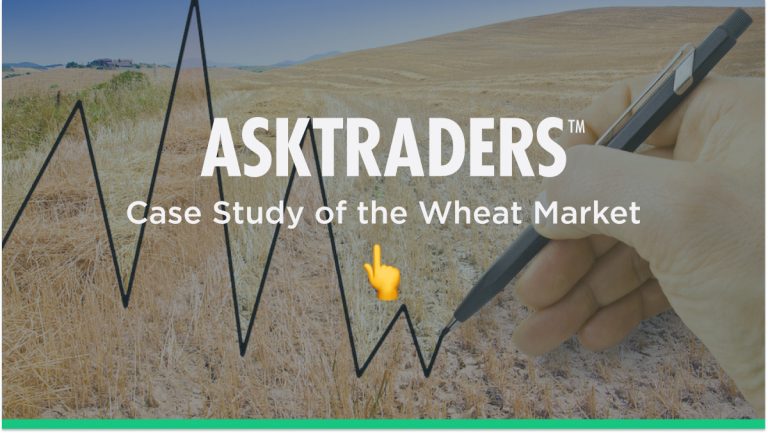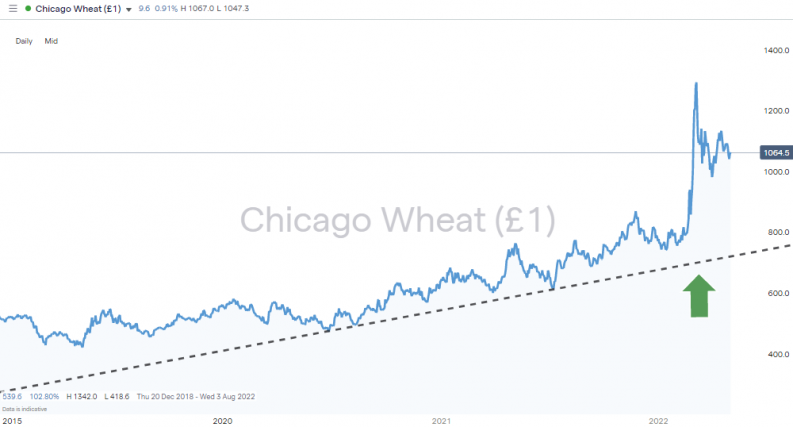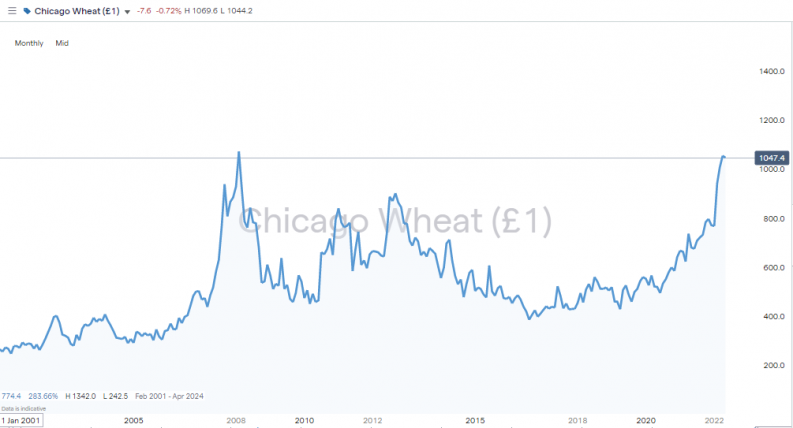
Commodity futures involve trading units of tangible assets such as oil, cotton, or copper. That means trading decisions can come down to someone having intimate knowledge of a sector or an intuitive understanding of how a particular trend will play out.
This step-by-step guide includes a case study of trading wheat futures and sets out the factors which need to be considered. If you get things right, serious profits can be made as futures markets tend to be at the higher end of the risk-return spectrum.
What is a Future?
A future is a contract between two parties to exchange a specific amount of an asset at a predetermined price on a predetermined date. The market evolved due to sectors of the economy, for example, manufacturers needing to guarantee a supply of a raw material required as part of their production process. Agreeing on the date and price of the item in advance is attractive to the buyer as it secures supply and removes the risk of price moving too high to make their business model viable.
Two parties can set up an OTC (Over The Counter) agreement for a futures transaction on any date. Most futures markets and those futures traded on exchanges have monthly expiry dates, so buyers in April can, for example, buy futures which expire in May, June, July and so on. The quarter-end expiry months, December, March, June, and September, have historically held added significance as three-month intervals fit with the business cycles of manufacturers and seasonal aspects of the agricultural sector.
What determines the price of Futures?
The price of a future will fluctuate in the run-up to the expiry date. An agreement to buy 100 bushels of wheat in two months will become a more attractive asset if a natural disaster means the global supply of grain will be lower than forecast. As a result, some speculators buy or sell futures with no intention of ever taking delivery of the underlying instrument but instead to capitalise on any price move between trade entry date and expiry date.
What is a Commodity?
Futures trading can be applied to any asset group. The ups and downs of stock indices, currencies, and bonds can, for example, be traded as futures. Commodities, which are standardised units of raw material, are well suited to be traded as futures. A futures market guarantees prices, which benefits both the supplier, for example, a farmer who knows what price they'll get for their crop, and the buyer, who can mitigate supply chain risk.
A Case Study of a Futures Market – Wheat
The below price chart of the Chicago Wheat Futures market illustrates the similarities and differences between futures markets and other asset groups such as equities. Between April 2019 and February 2022, the relatively low price volatility and upward trendline mark a steady price rise. This can be attributed to macroeconomic fundamentals, including supply-side snarl-ups as the global economy got into full swing after the Covid pandemic. Oil prices have also been rising over the last 18 months, and transport costs make up a large part of commodity prices. The rural areas where wheat is produced are often far from the urban areas where wheat products are manufactured and sold.
Chicago Wheat – Daily Price Chart – December 2018 – May 2022

Source: IG
The price spike in February 2022 saw the price of wheat futures surge by 56% in the 11 trading sessions between 22nd February to 9th March. This price shock was attributed to the conflict in Ukraine, which jeopardised the supply of wheat from that area. Ukraine is the world's ninth-largest producer of wheat (20.2m tonnes per year), and the Russian Federation is the third-largest producer (85.8m tonnes per year).
Futures price moves can rapidly build momentum, as in the case above. Buyers stepped in to the market to ensure they held futures which guaranteed delivery of wheat at a future date, and as that drove the price up, more and more buyers were forced to show their hand.
The wheat from Ukraine-Russia is typically used to produce bread and is exported internationally. Bread manufacturers were left with the choice of risking missing out on securing supply and leaving their plants running under capacity or locking in supplies in the hope of passing the extra cost on to consumers.
High Price Volatility in Futures Markets
It's entirely possible for another asset to experience a price move on that scale. The stock price of a firm might move similarly if the company's management makes an important announcement that catches investors off guard. Stock prices are, though, typically less volatile. The newsfeed to stock investors can be more easily managed by the firm offering incremental guidance.
In contract commodity futures can be impacted by a broader range of surprise events such as war and adverse weather conditions. Price is still a function of supply and demand, but the role of ‘acts of God' can make both variables harder to predict.
Chicago Wheat – Monthly Price Chart – May 2001 – May 2022

Source: IG
How to Trade Wheat Futures
Whether you're looking to buy wheat for your company's processing plants or making speculative bets on short term price moves in the market, trading futures traditionally requires accessing a futures exchange. As with equities, several exchanges around the globe have sprung up to allow buyers and sellers to interact. As with equities, the leading exchanges in the world are in the US.
The Chicago Board of Trade (CBOT) is, for historical reasons, based near the agricultural heartland of the US, which is one of the world's biggest producers of agricultural commodities. CBOT's leading role in the trade of global commodities means price moves there are often replicated on other exchanges around the world.
Physical Delivery
In a nod to the fundamental reasons why exchanges were set up in the first place, wheat futures are traded with the holder of the future on expiry day being obliged to take delivery of the amount of wheat stipulated. There are anecdotes across Wall Street and beyond of speculative traders failing to exit a position before expiry and finding a fleet of lorries carrying grain queuing up outside their Manhattan office, wondering where to offload their cargo.
Regulation is provided by FINRA Financial Industry Regulatory Authority which monitors the activity of brokers and ensures markets operate efficiently.
Cash Futures
Cash futures remove the risk of unintentional physical delivery. On the expiry date, the futures are settled according to the price the market is trading at, with the holder of futures receiving a cash payment.
What is Futures Rolling?
Both physical and cash futures can be ‘rolled'. It is the process of selling short-dated futures and buying longer-dated ones. This process puts off the deadline by which a strategy will come to a natural conclusion. It results in the holder incurring frictional costs in terms of trading commissions and trading across the bid-offer spread on two legs of the same trade. Even with those added costs factored in, it can be cheaper to roll contracts rather than just buy long-dated futures as the nearer dated months are much more liquid, which means spreads are tighter.
If you're looking to hold a futures position for months rather than weeks, carrying out a complete cost-benefit analysis can avoid losing out on frictional costs that can stack up.
What is Futures Margin?
Margin is capital put upfront by futures traders to ensure they can meet any obligations to other parties if their trading decisions result in a loss. Initial margin is the amount required to open a trade, and ‘margin calls' also need to be factored in. ‘Calls' are demands for extra collateral to be supplied due to a position trading at a loss.
The minimum initial margin required for a speculator to trade wheat futures on CBOT is currently $3,375. The amount of margin needed can be changed at the exchange's discretion. During times of increased price volatility, all traders might be asked to increase the amount of cash on deposit.
Easy Ways to Trade Wheat
The barriers to entry into the wheat market have traditionally resulted in futures exchange trading being an approach taken by only the most experienced traders. The interest in the wheat market and the chance to make significant returns have resulted in online brokers offering wheat CFDs. Contracts for Difference (CFDs) are similar to a future in that they are derivative financial instruments – they derive price value from the movement of an underlying asset, such as wheat. As a result, a derivative's price is not a function of inherent value but changes in the price of the instrument being tracked.
Part of the appeal of wheat CFDs is that less capital is required to be able to trade the market. Some online broker accounts on this list of trusted brokers allow new traders to set up accounts with less than $100.
The online broker platforms which support wheat CFDs offer other markets as well. From one account, it is possible to trade wheat CFDs, other commodities, equities, bonds, options, shares, forex, and crypto. The platforms are also user-friendly with intuitive functionality, ideal for beginners, and risk management tools are provided as part of the package. Stop-loss, take-profit and limit orders are ways to automate the price levels at which you buy and sell wheat. These instructions are built into the system and allow you to set up your portfolio and then take a hands-off approach.
Online brokers still take their price feeds from exchanges such as CBOT, so clients are still making a profit or a loss according to real market moves. It's just that CFDs are a more convenient way of accessing the wheat market than exchange-traded futures.
Things to Know About Trading Wheat Futures
Many investors find something appealing about the intuitive nature of commodities trading. The natural life factors which impact price can feel easier to grasp than the complex balance sheet adjustments which drive equity prices. There are some aspects of the market that are worth keeping in mind.
Commodity Markets Are Fast Moving
Commodity price moves can be dramatic and sudden. Heightened geopolitical risk and freak weather events can take place overnight. The fast-moving nature of the market means that news events need to be followed closely. Another way to keep up with the markets is to select a broker which offers price alert messaging, which involves the broker notifying you when prices reach a certain level.
Dynamic market conditions aren't necessarily a problem, particularly if you make the right calls. They also mean that your capital isn't tied up in a slow-burn position. There is room for buy-and-hold strategies relating to undervalued stocks, but a well-diversified portfolio has space for strategies which offer a little more risk return.
Best Brokers for Trading Commodities
Not all brokers offer commodity trading. Those who do might limit the number of markets on offer to gold, silver, oil, and gas. One broker that does offer markets in wheat, as well as other soft commodities such as cotton and soybeans, is IG.
A Global Market
Commodity prices are global. One of the prerequisites of commodities is that a bushel of one category of wheat in Australia should be close to a bushel of that same category of wheat farmed anywhere else in the world. That allows for the standardisation of products so that buyers get what they think they are buying. It also means price shocks can come from any direction or part of the world but be felt across the entire market.
Demand for commodities is also global. One trend identified in Q1 of 2022 was that consumers in lesser developed countries were more willing to substitute wheat for an alternative food source, but that ‘Western' consumers have been more willing to take on the increased prices. Such nuances need to be factored in when trying to predict future price moves in commodities.
Welcome to the Commodity Supercycle
Events in Ukraine brought the wheat market to the attention of international investors, but a steady price rise was evident on the wheat price chart even before that conflict broke out. The global economic landscape is changing, and long-term gains could be made by trading the commodities supercycle.
Final Thoughts
CFD instruments take a lot of hassle out of what can be a complicated process of opening a futures account, finding the required initial margin, and then managing rollovers. Whether you're an experienced investor or novice trader, heading to one of these shortlisted brokers will help you set up to trade the wheat market in a cost-effective and user-friendly way.
